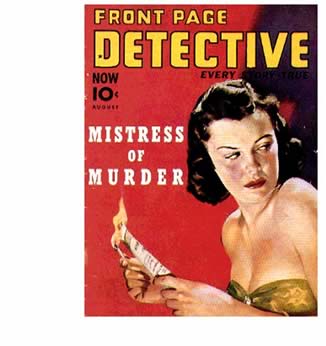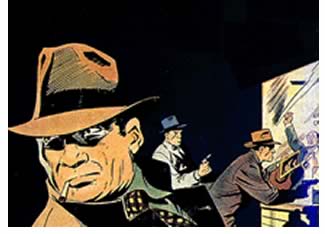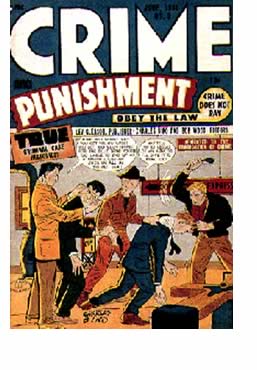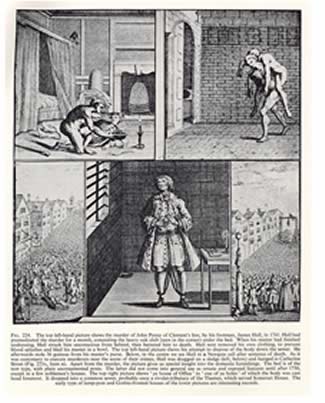Tales of Crime -
INTRODUCTION
The invention
of the crooked narrative is a major issue for us. It can involve the invention
of the assumed personality (as in Fantomas ) or in the
invented scenario ( Lies ). It can be the artist who
transmuted ( Marcel Duchamp ). It can be the designs of the Great Prestidigitator
( Welles and F for Fake ). Crime as an issue has been
the basis of much of our creative activity. Who wants to scrutinise the
motives of well meaning, beautifully balanced conformists in a world of
harmony and obedience ? The word has rich possibilities in the attempt
to understand the motivations of the individual, the group and our relationship
to the State.
In photographic
terms, the concept offers a wide range of possibilities in format and
technique, in exploring narrative and sequence. The word "crime"
can have personal ethical associations, not just crime passionel , but
be manifested as the commission of a crime in a relationship.
1. Meaning:
find your own way around the linguistic, ethical and legal possibilities,
but the Shorter Oxford Dictionary says, 1. an act punishable by law, as
being forbidden by statute or injurious to the public welfare (Commonly
used only of grave offences. b.violation of law.
2.an evil
or injurious act; a (grave) offense, a sin 1514. b.wrong doing.
3.Charge
or accusation; matter of accusation. See also Criminal, Crimeless, Incriminate.
This of course has set more problems than are solved. In what context
is the crime committed? When is a crime justified, and by whom ? Is there
an absolute crime ? Can a perfectly innocent act be a crime somewhere
in the world ? Is the word 'crime" merely the disapproval of that
group which holds the greatest power in society ?
2. Interpretation. Look
at Roget's Thesaurus and Brewer's Dictionary
of Phrase and Fable ,The Screw Plot, The Ten Great Persecutions,
Killed by Inches, The Know Nothings.
3. The Representation of Crime :
3.1 literary ;
Dickens, Zola and the Nineteenth Century Realist novel ( Oliver
Twist ,Crime and Punishment ,Thérèse Raquin ),
and the pioneer detective fiction of Wilkie Collins ( The Woman
in White, The Moonstone ), exploring the cityscape of crime,
the temptations besetting the individual in a variety of scales, from
the consequences of individual confusion to the grandiose attempt to overthrow
a whole legal code.
In the Twentieth
Century , the rise of Detective fiction (the country house murder, see
George Orwell's essay on the English Murder) and the Pulp Novel and the
Hard Boiled Detective. The state of mind of the petty criminal, the psychological
motivation of the agents of justice. The Surreal crimes of Fantomas the
Evil Criminal and Master of Disguise who so influenced Magritte. See Fabulist
accounts of crime by William Burroughs ( The Wild Boys, The Ticket
that exploded etc), Charles Bukowski and American Lowlife crime,
the bizarre embezzlements of Nikolai Gogol's Dead Souls .
The development of crime reportage in the newspapers, the capture of Dr.Crippen,
the execution of Dr.Landru the mass murderer, see Carey, booklist. In
terms of reportage that tends to fiction, see Truman Capote, In
Cold Blood ; Robert Bloch, Psycho .
3.2 the
manufactured image :
painters have been less interested by the actual recording of the commission
of a crime but more with the mythic overtones of murder, theft and duplicity,
and the fascinating mechanisms of justice. The Bible presents a range
of possibilities from Cain and Abel to crucified thieves. Particularly
popular are studies of dramatic time, the moment when... paintings, the
stabbing, the setting fire to, the moment of realisation of the true nature
of the deed. Painters have also favoured the predicament of the prisoner,
morbidly dwelling on the isolation, torture and despair of the prison
cell, the Man in the Iron Mask, Piranesi's I Carceri, Wheatley's Mr Howard
offering relief to prisoners, Prometheus chained to a pillar for stealing
fire from the Gods, condemned to daily loss of liver from eagle bites.
Think of Daumier's representations of lawyers, clerks and the full apparatus
of the State's machine for punishing the transgressor. The celebrated
criminals of the 18th and 19th centuries were often recorded by painters
and caricaturists; Géricault, Cruikshank and Degas among others.
There was a strong tradition of satisfying the huge demand for details
about crime in the popular press and print industry, see Gretton, booklist.
Remember Francis Bacon's use of the image of the Nazi war criminal Adolph
Eichman in a bullet proof glass box when he was being tried in Jerusalem.
3.3 the
photographic image ;
photography was directly involved with crime from the date of its commercialisation.
see The First Image, booklist. Photographs were taken for identification
and subsequent processes of law (the mug shot, the identification parade).
There are photographs of the murderer Dr.Crippen escorted off the boat
by police, and the covert snap of the Electric Chair. Photographers with
high powered lenses have photographed the fabric of highjacking, threatened
kidnap victims and bank sieges. A list of photographs of crime;
William Warnecke, The Shooting of Mayor Gayner.1910
E.J.Spencer, The Mad Bomber, 1912.
Tom Howard, The Electrification of Ruth Snyder, 1928.
Hack Miller, St.Valentine's Day Massacre.
Dick Sarno, The Trial of Bruno Hauptman.
Harry Hall, The Tossing out of Sewell Avery 1944.
Yasushi Nagao, The Assassination of Asanuma, 1960.
Robert Jackson, The Shooting of Lee Harvey Oswald, 1963.
Boris Yaro, The Death of Bobby Kennedy, 1968.
The photographer most associated with Crime is Arthur Fellig (Wee
Gee), and a documentary about his life will be shown during the project.
3.4 the filmic image; possibly the most widely acceptable consumption
of the image of crime has been in the cinema, perhaps a catharsis of our
fear of criminal damage to our persons and property. The gangster/crime
film. The BFI study guide for teachers (Tom Ryall, established a set of
categories;
a)1930's
1. the classic
gangster film, ( Scarface, Little Caesar )
2. the FBI film ( G Men, Bullets )
3. the social background film ( Angels with Dirty Faces, Dead
End )
b) 1940's
1. the film noir ( The Big Sleep, The Maltese Falcon )
2. the police documentary ( The House on 92nd Street )
3. the morally orientated gangster film ( Force of Evil )
c) 1950's
1. the syndicate film ( Murder Inc. )
2. historical reconstructions ( Al Capone )
3. the forties thriller reprised ( Warning Shot )
d) 1960's/1970's
1. the police movie ( Dirty Harry )
2. film noir reprised ( Chinatown, Klute )
3. the classic gangster film reprised ( Scarface, Untouchables
etc.)
e) 1970's
The Godfather phenomenon, Taxidriver .
f) 1990's the Mafia film phenomenon, Godfather III.
g)The Chapbook
and Penny Dreadful
BOOKLIST
John Carey (ed) The Faber Book of Reportage Faber 1987
Thomas
Gretton Murder and Moralities Colonnade 1980
Thomas
Byrnes Rogues Gallery ,247 Professional Criminals Castle, New Jersey
1988 (originally 1888)
Stanley
Cohen, Jock Young, The Manufacture of News Constable
1982 see The production of knowledge by crime reporters; Crime waves
as Ideology; The determinations of news photographs; The social production
of news, mugging in the media.
Gail Buckland
First Photographs Hale 1980
Pam Cook
The Cinema Book BFI 1985
A.Fellig
(Wee Gee) The Naked City , Wee Gee's New York Da Capo
NY 1972,3
Kellow
Chesney, The Victorian Underworld , Penguin Harmondsworth
1974
|



















